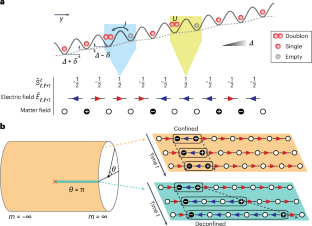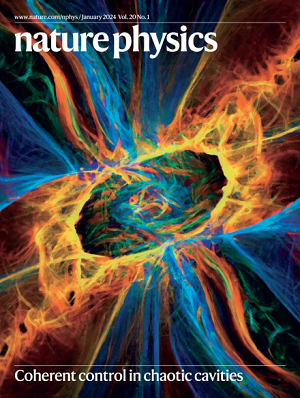Observation of microscopic confinement dynamics by a tunable topological θ-angle
IF 17.6
1区 物理与天体物理
Q1 PHYSICS, MULTIDISCIPLINARY
引用次数: 0
Abstract
The topological θ-angle is central to several gauge theories in condensed-matter and high-energy physics. For example, it is responsible for the strong CP problem in quantum chromodynamics and can emerge in effective theories of electrodynamics in topological insulators. Although analogue quantum simulators potentially offer a venue for realizing and controlling the θ-angle, doing so has hitherto remained an outstanding challenge. Here, we describe the experimental realization of a tunable topological θ-angle in a Bose–Hubbard gauge-theory quantum simulator, which was implemented through a tilted superlattice potential that induces an effective background electric field. We demonstrate the emerging physics through the direct observation of the confinement–deconfinement transition of (1 + 1)-dimensional quantum electrodynamics. Using an atomic-precision quantum gas microscope, we distinguish between the confined and deconfined phases by monitoring the real-time evolution of particle–antiparticle pairs. Our work provides a step forward in the realization of topological terms on modern quantum simulators. Topological terms arise naturally in gauge theories but have been difficult to implement in quantum simulators. Now, a tunable topological θ-angle is demonstrated with a cold-atom platform.


用可调拓扑θ角观察微观约束动力学
拓扑θ角是凝聚态和高能物理中几个规范理论的核心。例如,它负责量子色动力学中的强CP问题,并且可以出现在拓扑绝缘体的有效电动力学理论中。尽管模拟量子模拟器可能为实现和控制θ-角提供了一个场所,但迄今为止,这样做仍然是一个突出的挑战。在这里,我们描述了在玻色-哈伯德规范理论量子模拟器中可调谐拓扑θ-角的实验实现,这是通过倾斜的超晶格势来诱导有效的背景电场来实现的。我们通过直接观察(1 + 1)维量子电动力学的约束-定义跃迁来证明新兴物理学。利用原子精度的量子气体显微镜,我们通过监测粒子-反粒子对的实时演化来区分受限相和定义相。我们的工作为在现代量子模拟器上实现拓扑术语提供了一个进步。
本文章由计算机程序翻译,如有差异,请以英文原文为准。
求助全文
约1分钟内获得全文
求助全文
来源期刊

Nature Physics
物理-物理:综合
CiteScore
30.40
自引率
2.00%
发文量
349
审稿时长
4-8 weeks
期刊介绍:
Nature Physics is dedicated to publishing top-tier original research in physics with a fair and rigorous review process. It provides high visibility and access to a broad readership, maintaining high standards in copy editing and production, ensuring rapid publication, and maintaining independence from academic societies and other vested interests.
The journal presents two main research paper formats: Letters and Articles. Alongside primary research, Nature Physics serves as a central source for valuable information within the physics community through Review Articles, News & Views, Research Highlights covering crucial developments across the physics literature, Commentaries, Book Reviews, and Correspondence.
 求助内容:
求助内容: 应助结果提醒方式:
应助结果提醒方式:


